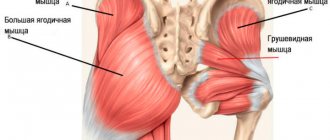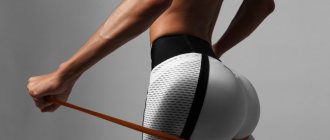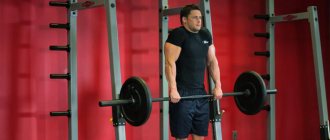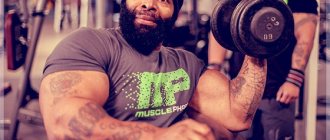The working weight in squats or leg presses and the height of the jump largely depend on the condition of the hamstring muscles. Quadriceps are, of course, important, but legs look truly developed only if you have developed hamstrings. Take a close look at the legs of world-class athletes: you will see not only impressive quadriceps, but also powerful hamstrings.
Anatomy
Anatomy of a hamstring
Start
- Long head: ischial tuberosity of the ischial ramus.
- Short head: linea aspera and lateral supracondylar line of the femur.
Attachment
- Lateral surface of the head of the fibula.
Innervation
- Long head: tibial nerve (L5-S2).
- Short head: common peroneal nerve (L4-S1).
Blood supply
Medial circumflex femoral artery, inferior gluteal artery, perforating arteries of the deep femoral artery.
Squats with dumbbells for hamstrings!
In essence, this is a similar exercise to the previous one, but lighter, since dumbbells are used instead of a barbell. A method well suited for inexperienced athletes who want to work their hamstrings. The gluteal muscle is not very actively involved in this embodiment.
Take the starting position typical for squats, first holding dumbbells in your hands. Your arms should be straight and the dumbbells should be parallel to the floor. Feet are level on the floor, slightly wider than shoulder width. Squat without leaning forward, keeping your back straight, moving your pelvis, but not your knees.
Function
Movements
- Long head: flexes the knee, extends the hip, laterally rotates the tibia when the knee is slightly flexed, promotes lateral rotation of the femur when it is extended at the hip joint.
- Short head: flexes the knee, rotates the tibia laterally with the knee slightly flexed.
Functional contribution
- Due to the characteristics of its origin and attachment, the long head of the biceps femoris provides posterior stability to the pelvis.
- Both heads provide rotational stability to the knee joint by preventing anterior translation of the tibia relative to the femur during knee flexion.
- The connection with the arcuate popliteal ligament also provides varus and rotational stability to the knee joint.
Barbell squats for hamstrings!
The exercise is performed with the legs wide and is aimed at working not only the biceps femoris muscle, but also the back, abs and shins. This is a rather difficult exercise, not very suitable for inexperienced athletes, as injuries are likely. But if you have already decided, then be sure to study under the supervision of a trainer.
Straighten your back, tighten your abs and lower back muscles. The bar can rest either on the back of the deltoids or trapezius, or in front of the forearms so that the outer part of the arms is parallel to the floor. Start into a squat by pushing your hips back rather than pushing your knees forward. Imagine that you are sitting in a chair or chair.
During a squat, the legs should bend at the knees until a right angle is formed, and the knee itself should remain motionless, not wagging to the sides, it should not bend or extend beyond the foot. If this happens, there is a high chance of injury. Do not place your center of gravity on your toes, trying to distribute the weight over the entire foot, but in peak phases, resting your heels on the floor.
As you lift the barbell, you should feel your hamstrings and gluteal muscles tighten. Please note that the deeper you squat, the more the buttocks will work, but not the hamstrings, that is, the emphasis will shift from one muscle to another. The goal is different, so it is preferable to squat to a right angle. It is also worth choosing the width of the legs and the angle of slight turn of the feet, which will be convenient for each individual trainee. An indicator that the chosen position is exactly what is required will be the feeling of extreme work of the biceps muscle.
Clinical relevance
Thus, we know that the biceps femoris muscle has 2 heads, namely a short head and a long head. These two heads attach to the head of the fibula, where they are divided into two parts by the fibular collateral ligament. Any subluxation or dislocation of the biceps femoris tendon or its abnormal insertion, as well as any injury or instability of the meniscus, can lead to a rupture of the tendon of this muscle.
Friends, Dmitry Gorkovsky’s seminar “Myofascial release (scientific approach to increasing joint mobility)” will take place very soon. Find out more...
This is a fairly rare condition that is characterized by pain in the lateral aspect of the knee. In this case, the head of the fibula may be convex, and painful clicking sounds may be heard during active and passive flexion of the knee 90 degrees. Problems may also arise with activities of daily living and playing sports.
Since this is a rare phenomenon, not enough information has been collected about it. Additionally, the exact cause leading to rupture of the biceps femoris tendon is still unknown. However, according to research, the occurrence of this condition can be associated either with excessive use, prolonged and intense physical activity, or is congenital.
This can occur during sprinting, resulting in a sudden change in running speed and pain in the posterolateral thigh (due to overexertion of the biceps femoris and semitendinosus muscles). Injuries to the long head and semitendinosus muscles are the most common among football players.
Why don't my hamstrings grow? What kind of training is needed for this?
This situation arises because during leg presses, lunges, squats with a barbell and other leg exercises, the hamstrings receive very little load, which does not allow them to grow properly.
Based on this, high-quality training intended for this muscle in isolation includes quite complex exercises that pose a danger to beginners. Therefore, if you want to pay utmost attention to pumping up this particular muscle, it is better to start doing this under the supervision and assistance of an experienced trainer. This way you will not only increase the level of effectiveness of your exercises, but also protect yourself from injuries.
It is also worth strengthening the hamstring muscles because, according to research, they are the most susceptible to various types of injuries. A quarter of all track and field injuries occur in this muscle group. It is assumed that the hamstrings are rather underdeveloped muscles, and therefore it is all the more necessary to develop their strength and endurance. However, such training should be approached with great caution by those people who have in the past injured or had diseases associated with the spine, hip or ankle joints.
As a rule, when starting to pump your legs, you don’t think much about the need to work your hamstrings. Of course, experienced athletes most often engage in isolated training for this muscle group, but without properly pumped hamstrings, the architecture of the legs cannot be given a complete look.
Inspection
Palpation
- Position the patient in the prone position with the knee slightly flexed.
- Locate the head of the fibula to help locate the insertion of the biceps femoris tendon.
- Then palpate the biceps femoris muscle (lateral part of the hamstring).
- Move toward the ischial tuberosity to palpate the belly of the muscle.
Muscle length testing
- The patient is positioned in a supine position.
- With one hand, locate the anterior superior iliac spine (ASIS).
- Use your other hand to support the patient's leg just above the ankle.
- Flex the patient's leg so that it remains straight (knee extended) and add tibial internal rotation to tighten the hamstrings.
- Shortening of the muscle can be judged by posterior rotation of the pelvic bone (PVB).
Trigger points
- Pain associated with trigger points of the biceps femoris (long and short heads) is localized in the back of the knee and can spread up the posterolateral surface of the thigh, up to the gluteal fold.
Features of hamstring training
Most exercises for the hamstrings also involve the gluteal muscles and partly the quadriceps, so it makes sense to create a general workout for the legs based on basic exercises and supplemented with isolating exercises specifically for the biceps muscle. This approach will ensure correct and even development of the hips, without shifting the emphasis to any part of them.
Effective and proper leg training is, ideally, strength training, so choosing good exercises for the hamstrings at home is quite difficult. Basic exercises require a barbell or dumbbells, while isolating exercises are difficult to perform without exercise equipment.
Before you start working the legs and back of the thigh, the muscles need to be warmed up. 10-15 minutes of running or walking on an incline will prepare you for your workout and eliminate the risk of sprains.
Hamstring leg curl!
The exercise is performed in the simulator in a position lying on your stomach, your shins should be under the supports. You need to bend your legs in such a way that your shins rise exclusively vertically. At the highest peak point, hold for a couple of seconds, then lower your legs and repeat the exercise the required number of times and approaches.
Make sure that the movements are smooth, without jerking and fairly slow. There is no need to rush and raise and lower your legs too quickly, this will not give the necessary load on the muscles. Do not put your legs on the support or overextend your knee joints, move your pelvis, keep your legs in an extremely tense state. Maintain your balance and position on the machine using your abdominal muscles. Listen to your body, paying attention to the fact that exactly the muscles that are needed are working.
Warm up well before strength training, and combine a hamstring workout with a not-too-heavy quadriceps or deltoid workout for best results.
sport
Hyperextension
This exercise has been known in fitness for quite some time, known for pumping up the lower back and relieving pain in the lumbar region. However, it can easily be modified and adapted for targeted training on the hamstrings. Hyperextensions are performed on a special structure called a Roman chair.
To perform classic exercises on a back extension machine, the emphasis is placed at the level of the upper pelvis, which practically removes the hamstrings from the list of active muscles, loading the lower back. If you lower the support pads to the level of the upper part of the quadriceps, then the main load will fall on the biceps femoris muscle and you will get an isolating exercise for working it out.
If in classic hyperextensions it is customary to bend forward, to pump up the hamstrings you need to try to bend back as far as possible, bending your knees. You need to lean forward slowly and smoothly, without making any sudden movements or jerks. Try to ensure that the body remains straight, only the knee joints should bend.
To complicate the exercise, pick up a plate, holding it on your chest or behind your back. Should be performed after basic training. This modified hyperextension exercise will be effective even if others could not cope with the task.
Romanian or deadlift for hamstrings!
Basic exercise using a barbell. Works the hamstrings, particularly the biceps and glutes. Before performing, carefully study the technique, this will save you from possible injuries, since the exercise is quite difficult and dangerous for people who are not accustomed to such loads.
When performing Romanian or deadlifts, make sure that your back remains extremely straight, because if it starts to round, this can lead to displacement of the vertebrae. Stand so that your legs are parallel and at a distance less than shoulder width apart.
With a straight back, lower yourself down, after inhaling deeply, so that the pelvis moves back and the body itself comes forward. The bar of the barbell should be as close to your legs as possible, touching them. When performing the exercise, the arms are straight and lowered down. Make sure your back doesn't round. When the bar is at the middle of your shins, start lifting, straighten up and stand straight with the sports equipment in your straight hands. When performing all these movements, the bar should slide along your legs.











